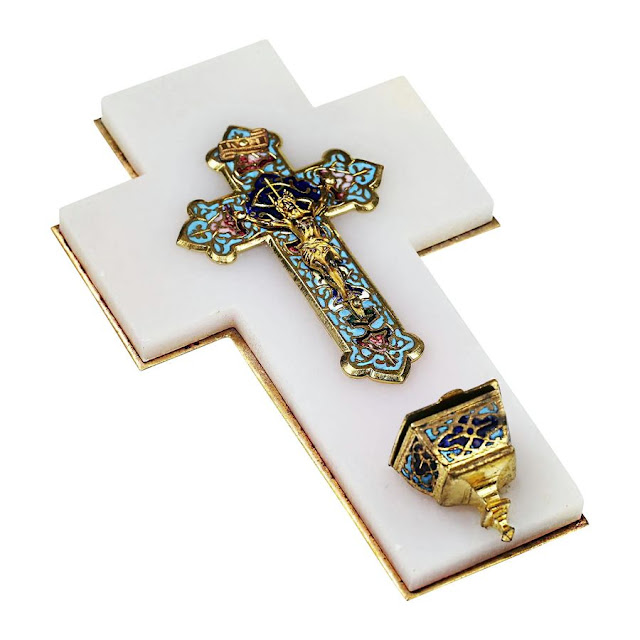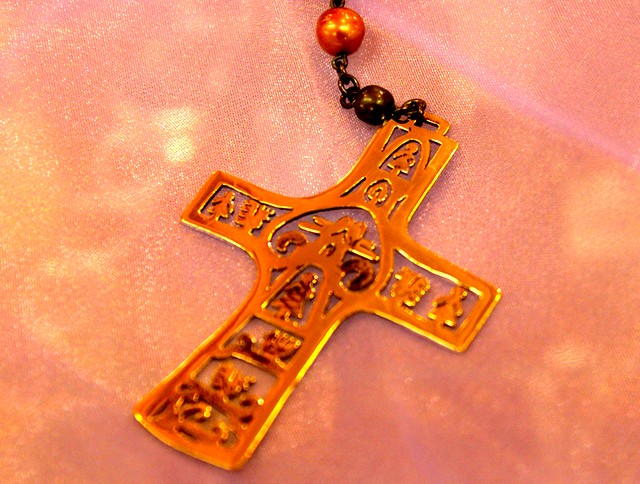
For several decades after WWII, churches and convents have poured their antique treasures on the market to raise funding for their institutions. These prodigal days are over, as the same institutions now seem to be buying them back, possibly following a trend started by Benedict XVI, who contrary to Pope John XXIII's simple white robe, is now seen wearing more traditional vestments with intricate lace, etc. This shift should ensure that the market of religious artifacts not only remains stable, but very likely increases for the next few years. Since the spectrum of cult objects is nearly infinite! I will only review here, artifacts I have been collecting, trading or closely watching.
There are 2 parts to this guide: Arifacts and Textiles.
Religious Arifacts
Crosses/Crucifixes
Crucifixes come in all forms and shapes with the most precious done in ivory and silver with abundance of extra characters. Walnut or darkened pear tree wood carvings from the Napoleon III period are also popular. Crucifixes can be standing pieces or wall pieces.

Micro Mosaic crucifixes made in Rome are also very much in demand. These micro mosaic pieces purchased by pilgrims to the Vatican, often have lovely representations of Roman monuments.
Holy water fonts
Very ornate, very decorative pieces made of various materials: embossed brass, marble, and even lucite during the Art Deco times.

They have a hollow shell at the front to hold the water brought back in bottles from the popular holy cities: Rome, Lourdes, Lisieux, etc.
Relics: Framed Reliquaries
These framed reliquaries are glass boxes which contain a genuine saint's relic at the back and are usually sealed with red wax. The relic can be a small piece of parchment, hair, even coffin dust!
At the front, reliquaries show a white porcelain figurine, an embossed embroidery, a wax scene, etc. often caught in incredibly delicate paper lace ribbons called: paperolles, with the names of the saints and mottos. The most popular of these mini shrines are Napoleon III black "bubble glass" oval frames. But reliquaries can be square, round, octogonal and also have a minuscule size.
Relics: Travelling Reliquaries
Usually pocket cylinders. with a mini statue of a saint or of the Madonna inside. They can be silver plate etuis covered with fleur de lis or bone carvings that reveal a figurine by rotation. Some pieces of religious jewelry were also travelling reliquaries, though these pieces are more ancient. For instance 17th C Knight of Malta crosses worn as pendants, contained a relic at the back in a glass compartment.
Rosaries & Medals
Rosaries have become hip bracelets for women and hip necklaces for men in the past couple of years. They range from plastic beads and rhodium, to solid silver, ivory, mop, coral beads. Religious medals/charms are also in demand, particularly blue guilloche silver medals.
Often made in Lourdes, which right after the sightings of the Virgin by young shepherds in 1858, became a center of religious pilgrimage, a touristic rival of Rome, and a distribution center of cheap religious artifacts. With time, even the kitschiest of the Lourdes tourists'production, and of course because of it! has become a collectible category.
Religious Textiles
Though there was still intense creativity displayed in church textiles shortly after WWII, one can safely say that in the second part of the 20th Century, there is a steep decline in all needlework done by hand, so the most prestigious collectibles are pre- 1950s European vestments, with a peak circa 1870-1900, times of obvious church and state wealth in Europe, and intense religious production.
There are still a number of 18th C pieces on the market, not necessarily in bad shape, as church embroideries were very heavy, with the metallic texture of fabrics, fringes and embroideries keeping vestments together, but these more ancient pieces are of course very faded and their gold and silver components quite tarnished. Still, they are among the most spectacular.
Vestments: Chasubles, Copes & Dalmatics
They are the colorful upper part of the priest garments. They are quite heavy fabrics assemblages, and are done in ritual colors: purple, black, etc. to celebrate the religious seasons of the year: Lent, Assumption, Easter, Xmas, etc.
They are sheaths with no sleeves, worn a bit like a body armor for the chasuble, with horizontal bands for the dalmatics and a capelet at the back for the copes.
A complete set includes a manipule, a purse, a chalice veil and a stole. All vestments are richly adorned with three dimensional satin stitch embroideries, embossed metallic thread motifs, trims and fringes. Most pieces are made of silk, sometimes silk brocades with gold thread, specially woven for the church. Motifs can be religious symbols such as lambs, birds, the sacred heart of Jesus, but also decorative representations of nature such as flowers, leaves, wheat ears, and of course grapes, which are both nature and symbol. Small gold sequins and beads can be present. 18th C vestments may include other themes like the pelican. Even small remnants of these rich garments have become hot collectibles, as these metallic motifs are so precious, they can easily compare to jewelry.











